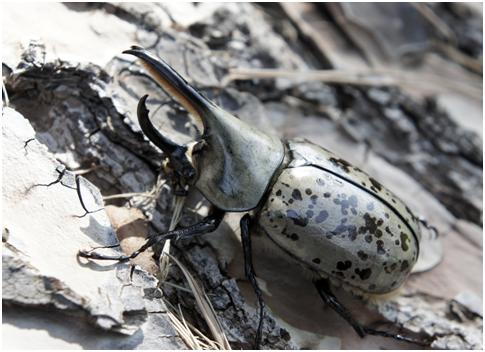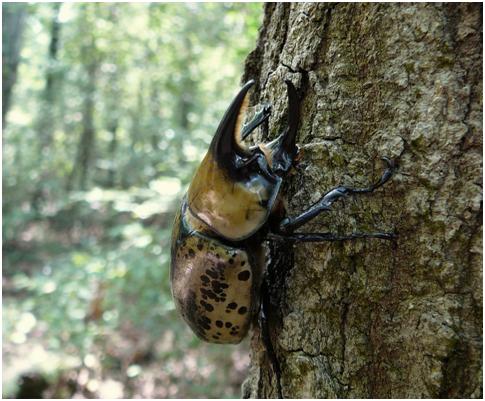 |
|
|
|

|
|||
| |
|||
The Western hercules beetle, Dynastes grantii, that lives in Arizona Pine-Oak mixed forests is the largest beetle in the US in terms of body size (2~3 inches) and weight. Adults of this beetle have grey background body color with irregular black spots, whereas the immatures are typical C-shaped white grubs. Adult beetles feed on tree sap but are not harmful to trees. Larvae feed on decaying wood and soil substrates. The distribution of this beetle is mainly limited to Arizona (5000~6000 ft elevation), but can also be found in Utah and New Mexico mountain ranges. In some area of Arizona, the Western hercules beetle can be quite common. We’ve observed 45 adults attracted to the black lights within 2 hours in the mountains near Payson, AZ this summer. Due to their nocturnal behavior, you will come across this beetle near a porch light, commercial billboard, or in a gas station near the forest. Another similar species, Dynastes tityus, lives in eastern US, and is commonly referred to as the Eastern hercules beetle. The distribution of this species is much more widespread than the Western hercules beetle, and it occurs in most of eastern and southern states. Unlike the pale-grey color of the Western hercules beetle, Eastern hercules beetles have olive green to yellow body color. The biology and ecology are pretty similar for both species. Hercules beetles are treated as pets in some Asian countries such as Japan and Taiwan where they are popular commercial products in the beetle shops because of their body size, longevity, and ease in rearing. The take home message here is that they are not agricultural pests, nor pests in forest ecosystems, thus chemical sprays to control them are unnecessary. In fact the larvae of hercules beetles are very important and efficient decomposers in our ecosystems which help the process of nutrient recycling. Western Hercules Beetle, Dynastes grantii Click picture to listen Click picture to listen to Ta-I To contact Ta-I Huang go to: thuang7030@email.arizona.edu
|
|||
| Back | |||
For questions or comments on any of the topics please contact Marco Pena at the Yuma Agricultural Center. |
|||
| Home | Cotton
| Veggies | Forages
| Grains | Citrus
| Crop x Crop Insects | Diseases| Weeds | Pesticides | Economics | News | Weather | Research | Photos | Contacts | General Info. Copyright © 2001 University of Arizona, College of Agriculture and Life Sciences Webmaster: Al Fournier (acis@ag.arizona.edu) |
|||


